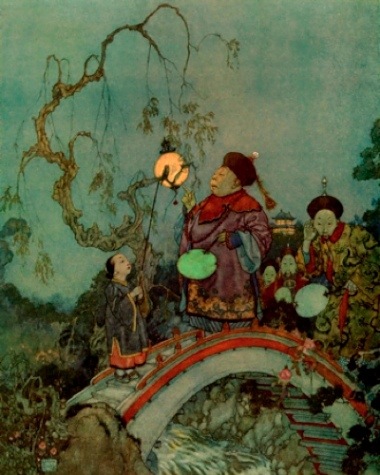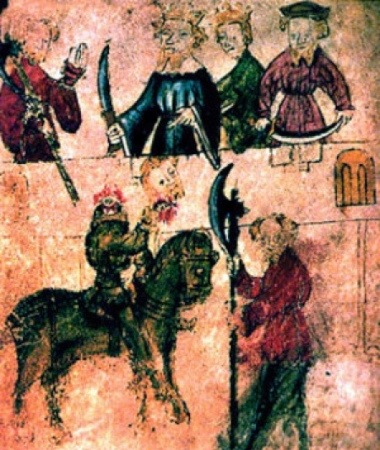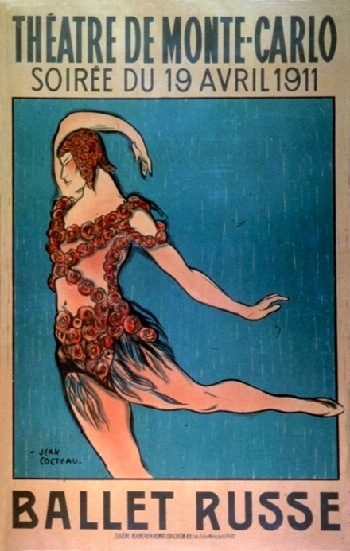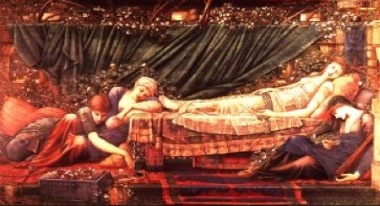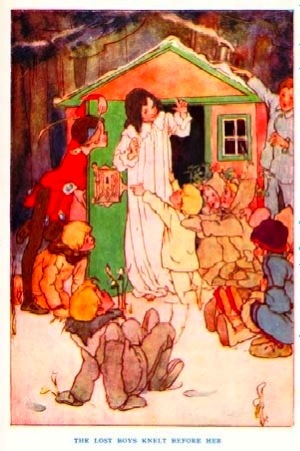“Vorspiel” from Parsifal
Richard Wagner
James Levine and the Metropolitan Opera
Making Ourselves Uncomfortable
 The Knights of the Round Table Summoned to the Quest by the Strange Damsel
The Knights of the Round Table Summoned to the Quest by the Strange Damsel
Sir Edward Burne-Jones
http://en.wikipedia.org/wiki/File:Holy_Grail_tapestry_The_Summons.jpg
Most of the achievements we are proudest of are accomplished by making ourselves uncomfortable. They involve struggle, hardship, and a fair amount of failure before there is success. There was an article recently in the Times Literary Supplement, “The miraculous G. K. Chesterton?”, on the life and “cheerfulness” of G. K. Chesterton. Some described it as a “silly” cheerfulness because it seemed to require an unrealistic view of the world. But it is suggested that he learned to craft cheerfulness from the materials he was given. This is, or ought to be perhaps, a byproduct of making ourselves uncomfortable. The cheerfulness does not make the journey less difficult; it only makes the hardship a bit more bearable.
The music is from Richard Wagner’s opera Parsifal. The story the opera tells is of the quest for the Holy Grail. The grail has come to represent in western culture the pinnacle of excellence in any field. Bernard Malamud’s novel The Natural tells the story of a baseball player seeking the “grail” of baseball, winning the league title and the opportunity to compete in the World Series. John Feinstein, a sportswriter, wrote a book, The Majors, about the major tournaments in golf. He subtitled this book “The Holy Grail of Golf” because to win one of these tournaments is to rise to the top of the golf world.
What all grail quests have in common is the great demands they place on those involved with the quest. The quest is a trial and brings with it suffering and great discomfort. In some ways this is a metaphor for everyone’s life journey. In Le Mort d’Arthur Thomas Malory, begins his telling of the Holy Grail story with an invitation, depicted in the painting above, to the quest. The knights accept the invitation and begin set off to seek the grail. Malory says of these knights as they start their quest, “And so on the morn they were all accorded that they should depart everyone from the other; and on the morn they departed with weeping cheer, and every knight took the way that he liked best.” In other words each knight rode down the main road and when he (at this time all knights were “he’s”) saw a spot in the woods that looked inviting set off on his own personal quest, leaving the road and entering an uncharted wilderness.
This might suggest to some the line from Robert Frost’s poem, “Two roads diverged in a yellow wood, and I – / I took the one less traveled by / And that has made all the difference.” Except if we read this poem Frost also tells us that both paths were worn “really about the same.” In Frost’s poem there are two roads, not one road and a going off into the unknown, and both roads had received about the same amount of foot traffic. This is not the kind of path that Malory was talking about when he described the knights going into the woods. Joseph Campbell, in a conversation with Michael Toms, quotes from another version of the story, “They thought it would be a disgrace to go forth in a group. Each entered the forest at a point he had chosen where it was darkest and there was no way or path.” The path these knights took was untraveled and chosen because it involved risk.
 The Arming and Departure of the Knights
The Arming and Departure of the Knights
Sir Edward Burne-Jones
http://en.wikipedia.org/wiki/File:Holy_Grail_Tapestry_-The_Arming_and_Departure_of_the_Kniights.jpg
This story of the knights setting out on their journey captures the journey each of us takes as we live out our lives. As children our parents select the paths we will take, where we will live (this may not always be the parents’ choice but it is certainly not the child’s), where we go to school, where or if we worship. Others, usually adults, play a significant role in teaching us the values we should embrace, the kind of people we should befriend, and the way we should view the world around us. At some point, though, we start to make our own decisions. At that point we leave the paths that have been chosen for us and enter the dark wood to pursue, . . . pursue what? Our own dreams and aspiration? That is part of it, but the real quest is to find ourselves, who we are as individuals, to establish our identities and we cannot really come to know ourselves without making ourselves uncomfortable.
But it goes beyond this. The paintings above and below depict people setting out on or in the midst of a journey. The painting above appears to be the beginning of a journey, it is peaceful, the moon is up and the sky is still dark. There are others on shore watching as the travelers set out over the bridge. Journeys, the easy ones and the most difficult, often begin with this kind of serenity that fosters hopefulness and optimism. There is a story in the painting, though we cannot know what it is. Though the man leading the horse and the man following the horse both seem alert and ready for the journey, the man on the horse seems slumped over and tired, weighed down by a burden of one kind or another. But in all other respects the landscape is peaceful and seems to provide an auspicious beginning to the journey.
The painting below is set in the midst of the journey after a catastrophe of one kind or another has struck. There are some people on a boat in high seas and what appears to be stormy weather. The sun shining behind the clouds may suggest hope for the future, but the present of the painting is of a small boat trying to make headway against high seas and a powerful current. There is a suggestion of landfall in the background far in the distance and tall waves yet to be encountered. We see the outlines of the people on the boat, but, unlike the picture above, not enough to draw any conclusions about how well they are enduring. When I look at the painting the first thing that comes to mind is the story of Odysseus fighting the waves Poseidon has thrown at him as he tries to reach the shore. He does eventually, after receiving a bit of help, but like the folks in the painting there were moments when the outcome did not look to be a happy one.
 The Ninth Wave
The Ninth Wave
Ivan Konstantinovich Aivazovsky
http://en.wikipedia.org/wiki/File:Aivazovsky,_Ivan_-_The_Ninth_Wave.jpg
There was a series of articles in The Guardian (“Yes, Teen fiction can be dark – but it shows teenagers they aren’t alone” and “Teen fiction accused of being ‘rife with depravity‘”) responding to an article in The Wall Street Journal on youth fiction, “Darkness too Visible”, that criticized the dark and violent nature of much of what is called Young Adult Literature (YAL). The concerns some parents might have that the Journal article points out are understandable, but then so are the points made by those writing in The Guardian. The problem with storytelling is that it is compelling because it captures the struggles, real and imagined, that people confront. The novelist Vladimir Nabokov did not care for happy endings and argued that stories that ended happily were not realistic. There may be truth to that but I suppose that largely depends on where one chooses to end the story.
Life is made up, for most of us, of a mix of happy and sad. And then of course, one must consider what is meant by a happy ending. Is a story that ends on a sad or melancholy note with a glimmer of hope a happy ending or a sad ending? When we finish a book like The Grapes of Wrath does the ending leave us feeling hope for the human race in general and the Joads in particular or does it leave feeling an overwhelming sadness. A lot depends on how we interpret the final moments of the novel. It is very difficult to connect with a story, to be captured by it, if we do not empathize with the characters and empathy is usually provoked by struggle and the hardships the characters encounter.
The fiction that many young adults read may be dark and violent, but than so is the fiction read by many adults who are not so young. Perhaps it helps us cope, perhaps it enables us to experience vicariously the adventures we cannot experience in reality. Which is worse, hardship or boredom? Most of the things in life that give us pleasure and make us happy only give us pleasure and make us happy because they are ephemeral, they do not last. The longer they last the more likely it is the pleasure will turn to ennui. This is not to say we should cut the good times short, enjoy them while they last, but appreciate the fact that they end before we are sated by them.
Arvind Gupta
TED Talk
The film is of a toy maker and his work. He uses simple everyday objects to make toys for children. These toys often teach principals of science and mathematics but they teach without interrupting the play. I think the film illustrates that our capacity for play is fed by imagination and I believe this to be true no matter how expensive the materials used to construct our toys. It also illustrates that learning is an act of the imagination; understanding often has its roots in our ability to imagine a principal at work. These toys were developed with poor children in mind but one need not be poor to get enjoyment from playing with them (one also need not be a child to play with them). Toys, like those Arvind Gupta makes, often ease the struggles of growing up and perhaps this takes us back to the stories young adults are reading.
Growing up is a struggle for most, no matter what advantages we are born with. The toys we play with often help us to shape our identities, they give us a chance to experiment with playing roles. Like stories where we imagine ourselves entering the wood where it appears to be the darkest and in our encounters with the darkness learn something about ourselves. It is in stories that we begin to explore who we are and question our ability to hold up under circumstances similar to those encountered by the characters in the stories. It is in play that we begin to act out some of the things we are coming to understand about ourselves. In any adventure, no matter how desirable it appears on the printed page or in the world of play, there is an element of danger that frightens us and fuels our self doubt. Those doubts can only be eased by the struggles and challenges we face and overcome in daily living.
 The Forging of the Sampo
The Forging of the Sampo
Akseli Gallen-Kallela
http://en.wikipedia.org/wiki/File:Gallen_Kallela_The_Forging_of_the_Sampo.jpg
The painting, The Forging of the Sampo, is from an event in Finnish mythology. No one really knows what the Sampo is; all that is clear is that it is a magical object that provides good luck and protection to whoever possesses it. The ambiguity that surrounds it makes it a useful metaphor for whatever it is that brings us good fortune because whatever it is, it is different for everyone. Most cultures have produced charms, talismans, amulets; objects of one kind or another that are usually worn that ward off evil of one kind or another and keep us safe and prosperous. Perhaps they work because we believe they will work, the way a placebo drug works on patients who believe they are being given a real cure. The stories we carry with us are often a talisman against the darkness we encounter, the troubles that life brings. If we never make ourselves uncomfortable we may have fewer encounters with the forces of fear and doubt. We may live more comfortable lives, but with this kind of comfort often comes a profound dissatisfaction and an emptiness that can only be filled by tribulations of one kind or another, and just as the talismans we each carry are unique to each of us, so are the troubles.
 Pacific
Pacific
Isaac Levitan
http://en.wikipedia.org/wiki/File:Isaak_Ilitsch_Lewitan_003.jpg















